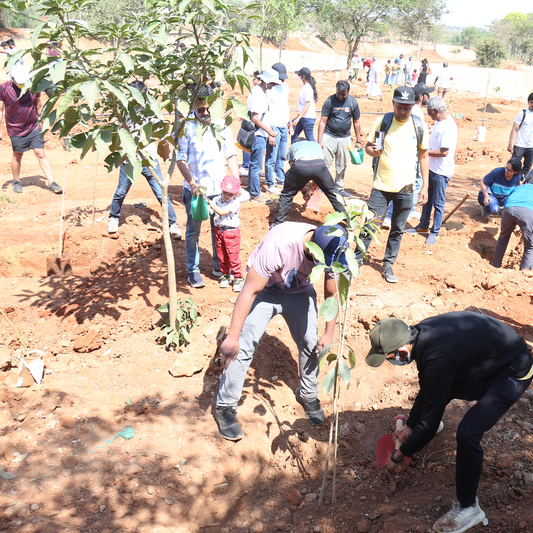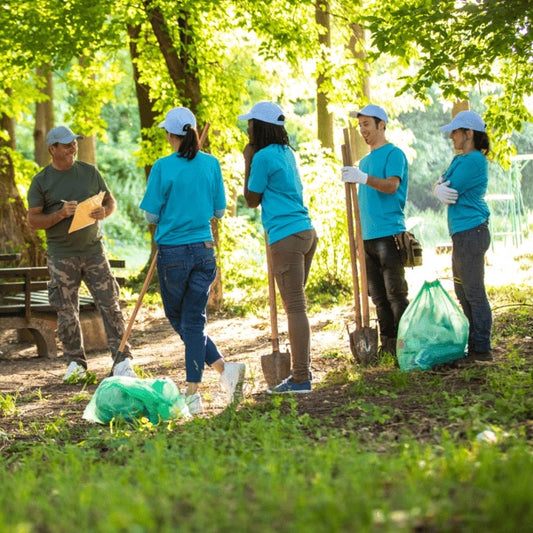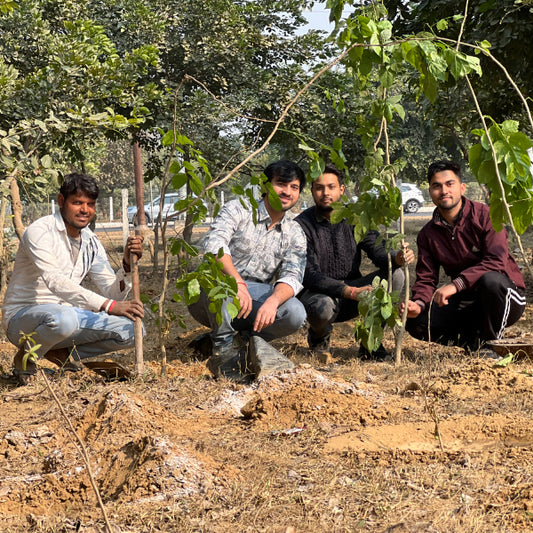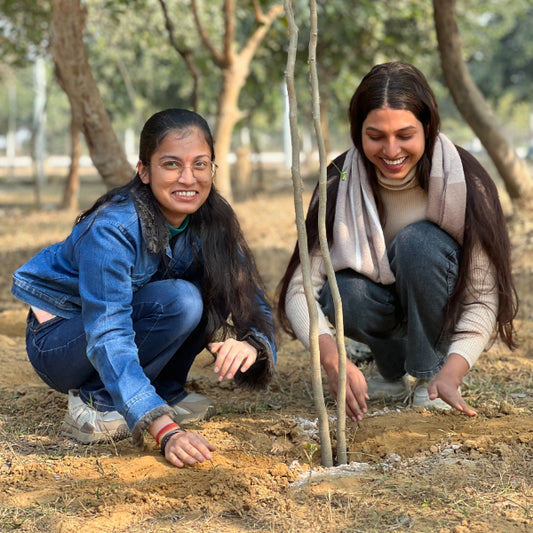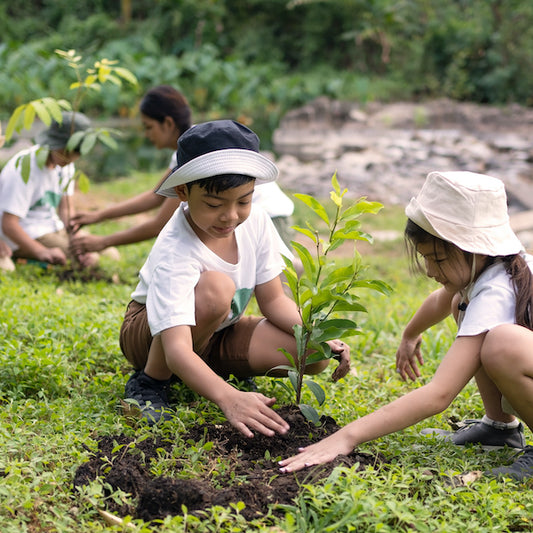Honoring Guests, Planting Prosperity: Forbes India’s Green Initiative for the Future
Forbes India recently organized a meaningful tree plantation initiative in the agroforestry concept, aptly named "Honoring Guests, Planting Prosperity Read more
Plantation Site Gallery
Project Update 1










Digital Forest
Forest with 15 Trees planted
Honoring Guests, Planting Prosperity: Forbes India’s Green Initiative for the Future
Forbes India recently organized a meaningful tree plantation initiative in the agroforestry concept, aptly named "Honoring Guests, Planting Prosperity." Centered on farmer-centric benefits, the initiative enhances income diversification through the sale of fruits and timber, improves livelihood resilience by reducing dependency on single crops, and lowers farming costs with natural soil enrichment. By interweaving trees with agriculture, the initiative also boosts crop productivity, strengthens local biodiversity, and promotes sustainable growth in rural communities. Honoring its esteemed guests through this initiative, Forbes India reinforces its commitment to environmental sustainability and community empowerment for a greener, more prosperous future.
Tree Plantation Date
24th October 2024
Plantation Location
Rajpur, Madhya Pradesh, 451447
Trees Planted
Total Count: 15 Trees
Forest Type: Agroforest
Forbes' tree plantation initiative focuses on the agroforestry concept, a sustainable land-use system where trees and shrubs are planted alongside crops or livestock. This method fosters a mutually beneficial relationship between agriculture and forestry, enhancing biodiversity and improving soil fertility while providing natural pest control and shade. Forbes' approach to agroforestry promotes ecological balance by reducing carbon emissions and promoting water retention, while also improving agricultural productivity. By integrating trees with farmland, this initiative supports both environmental health and local communities, offering a sustainable model for agricultural growth and climate resilience.
Advantages Of Agroforest
Enhanced Biodiversity
By integrating trees with agricultural crops, Forbes fosters a diverse ecosystem that supports various plant and animal species. This biodiversity contributes to a balanced ecosystem, improving pollination and pest control.
Improved Soil Health
Trees enrich the soil with organic matter, enhancing nutrient cycling and reducing the need for chemical fertilizers. The roots of the trees also help prevent soil erosion, promoting healthier, more fertile land for farming.
Carbon Sequestration
Trees absorb carbon dioxide (CO2) from the atmosphere, effectively mitigating climate change. This carbon sequestration helps reduce greenhouse gas emissions and contributes to global climate goals.
Sustainable Agricultural Practices
The presence of trees creates microclimates that improve growing conditions for crops, leading to higher yields. Agroforestry also encourages natural pest management, reducing the reliance on chemical pesticides.
Economic Diversification
Agroforestry provides farmers with multiple income sources through the sale of timber, fruits, nuts, and other tree-based products. This diversification can enhance financial stability and resilience against market fluctuations.
Climate Resilience
Agroforestry systems are more resilient to extreme weather conditions, making them adaptable to climate change. Trees help retain soil moisture and protect crops from harsh weather, contributing to more stable agricultural production.
Water Management
The integration of trees in agricultural landscapes improves water retention in the soil, reducing irrigation needs. This is particularly beneficial in areas prone to drought, promoting sustainable water use.
Community Benefits
By promoting agroforestry, Forbes supports local communities by enhancing livelihoods and creating job opportunities related to tree management and agricultural production. This strengthens community ties and fosters collaboration.
Activities During Tree Plantation
Forbes conducted a tree planting activity focused on promoting environmental sustainability and enhancing agricultural productivity through the agroforestry approach. The event started with local farmers preparing the land, carefully cultivating it for optimal plantation conditions. Trenches were dug systematically across the fields to improve water retention and minimize soil erosion, creating a conducive environment for saplings. Native tree species were then strategically planted, with careful attention given to positioning to maximize their growth and ecological impact. Post-planting, farmers ensured the saplings were well-watered and nurtured with essential nutrients to encourage healthy development. This initiative highlights Forbes' dedication to environmental stewardship and sustainable agricultural practices.
Tree Plantation Purpose
1. SDG 1: No Poverty
By providing additional income streams through the sale of timber, fruits, and other tree products, the agroforestry initiative helps reduce poverty and improve farmers' economic stability.
2. SDG 2: Zero Hunger
Agroforestry enhances food security by improving soil fertility, increasing crop yields, and making agricultural systems more resilient to climate-induced challenges.
3. SDG 6: Clean Water and Sanitation
Trees enhance water retention and reduce soil erosion, improving water conservation and protecting the quality of water resources for local communities.
4. SDG 8: Decent Work and Economic Growth
The initiative creates jobs in land preparation, tree planting, maintenance, and harvesting, fostering sustainable economic growth in rural areas.
5. SDG 12: Responsible Consumption and Production
Agroforestry promotes responsible resource use by reducing the need for chemical inputs and encouraging sustainable farming practices that protect the environment.
6. SDG 13: Climate Action
Trees absorb carbon dioxide, reducing greenhouse gas emissions, while also improving the resilience of agricultural systems to climate change, particularly extreme weather events.
7. SDG 15: Life on Land
The initiative conserves biodiversity by creating habitats for wildlife, while also promoting sustainable land use practices that prevent deforestation and land degradation.
These points encapsulate the diverse benefits of Forbes’ tree plantation initiative through the lens of the SDGs.
Through Forbes' tree plantation initiative using the agroforestry concept, several Environmental, Social, and Governance (ESG) goals are achieved:
Environmental (E)
Forbes' tree plantation initiative, utilizing the agroforestry concept, significantly contributes to environmental sustainability. By integrating trees into agricultural landscapes, the initiative supports carbon sequestration, helping to reduce greenhouse gas emissions and mitigate climate change. The planting of native tree species enhances local biodiversity, creating habitats for various wildlife and promoting ecosystem resilience. Additionally, the trees play a crucial role in soil and water conservation by reducing soil erosion, improving water retention, and enriching the soil with organic matter. These practices promote sustainable land use, reducing deforestation and fostering long-term environmental health.
Social (S)
Socially, Forbes' agroforestry initiative actively engages local communities, particularly farmers, by providing education and training on sustainable tree planting and land management practices. This involvement empowers farmers with the skills and knowledge to enhance their agricultural productivity while protecting the environment. The initiative also improves livelihoods by diversifying income sources through the sale of tree-based products such as fruits, timber, and other resources, boosting economic resilience. Furthermore, by improving soil fertility and water retention, the initiative contributes to better crop yields, supporting food security for local communities and fostering social responsibility through community-driven sustainability efforts.
Governance (G)
Forbes has strengthened its Governance within its ESG framework by partnering with Grow Billion Trees in its agroforestry tree plantation initiative. This collaboration exemplifies Forbes' commitment to sustainability by ensuring that the initiative aligns with best practices and global standards for environmental stewardship. Grow Billion Trees, with its expertise in large-scale tree planting, provides the necessary oversight, ensuring transparency, accountability, and adherence to ethical practices throughout the project.
By working with Grow Billion Trees, Forbes ensures that tree species are selected, planted, and maintained sustainably, while also involving local communities in a responsible and inclusive manner. Through this partnership, Forbes upholds governance principles that drive accountability, transparency, and sustainability, showcasing its dedication to ethical leadership and the responsible management of environmental initiatives.
Commitment by Grow Billion Trees
Grow Billion Trees is committed to driving sustainable plantation efforts, ensuring every initiative aligns with key environmental objectives and promotes long-term ecological balance. They focus on selecting native tree species that are well-adapted to local ecosystems, ensuring a higher survival rate and stronger environmental impact.
To maintain plant health and longevity, Grow Billion Trees emphasizes continuous maintenance and regular monitoring of the plantations. This approach helps ensure that each tree thrives, contributing effectively to both biodiversity and climate resilience.
Transparency is a core principle in their operations. Clients receive comprehensive reports, including geo-tagging of planted trees, survival rate updates, and ongoing progress reports. This level of openness allows clients to track the direct impact of their contributions, reinforcing trust and accountability.
Through their dedication to sustainable practices, Grow Billion Trees ensures that every plantation project leaves a lasting positive footprint on both the environment and the local communities it serves.
Summary
Forbes' tree plantation initiative, rooted in the agroforestry concept, integrates sustainable environmental practices with agricultural productivity. By planting native tree species alongside crops, the initiative enhances biodiversity, improves soil health, and promotes water conservation, creating more resilient ecosystems. It also supports local communities by providing additional income through tree-based products like timber and fruits, while improving food security through better crop yields. Partnering with Grow Billion Trees, Forbes ensures transparency, ethical practices, and long-term sustainability, aligning the initiative with global environmental goals and reinforcing its commitment to both environmental stewardship and community development.
Trees for Corporates
Trending
Most Popular
FAQ
What is Forbes’ tree plantation initiative in agroforestry?
Forbes' tree plantation initiative focuses on agroforestry, blending tree planting with agriculture to enhance biodiversity, improve soil health, and support sustainable farming. Through this initiative, Forbes aims to promote environmental sustainability while benefiting local communities by increasing agricultural productivity and providing additional income sources from tree-based products. This initiative helps Forbes align with global sustainability goals, supporting both environmental and economic development.
How does agroforestry help the environment?
Agroforestry benefits the environment by integrating trees into farming systems. Trees improve soil health, enhance water retention, and reduce erosion. Additionally, they sequester carbon, helping mitigate climate change, and support biodiversity by creating habitats for various species. Forbes' agroforestry initiatives aim to promote these environmental benefits on a large scale.
How does Forbes support local communities through agroforestry?
Forbes empowers local communities by offering training and resources to adopt sustainable agroforestry practices. This initiative enhances farmers' livelihoods by diversifying income sources from trees (e.g., timber, fruits) while increasing agricultural productivity. Agroforestry provides local communities with long-term economic stability, fostering sustainable rural development.
How does agroforestry reduce carbon emissions?
Agroforestry helps sequester carbon by planting trees that absorb CO2 from the atmosphere. Forbes’ agroforestry initiative actively reduces its carbon footprint by integrating trees into agriculture, turning farmland into carbon sinks. This method supports the fight against climate change by storing carbon in biomass and soil, making agroforestry a climate-smart practice.
What tree species does Forbes plant in agroforestry initiatives?
Forbes focuses on planting native and regionally appropriate tree species that are well-suited to the local environment. These species help maintain biodiversity, support ecosystem health, and provide valuable products like timber and fruits. By selecting native species, Forbes ensures the trees adapt well and contribute to long-term ecological balance.
How does Forbes’ tree plantation initiative contribute to sustainable agriculture?
Forbes' agroforestry initiative contributes to sustainable agriculture by integrating trees with crops, which improves soil fertility, enhances water management, and promotes natural pest control. These factors lead to higher crop yields and reduce reliance on chemical inputs, creating a more sustainable agricultural system.
How does Forbes monitor the success of its tree plantation efforts?
Forbes works with partners like Grow Billion Trees to monitor the success of its agroforestry initiatives. This includes tracking tree growth, survival rates, and the environmental impact of the project. Data collection ensures transparency and helps Forbes report on sustainability progress, aligning with its commitment to corporate responsibility.
Why is biodiversity important in agroforestry?
Biodiversity is crucial in agroforestry because it enhances ecosystem resilience, improves soil health, and supports various species. Forbes’ agroforestry projects focus on planting diverse tree species that provide habitats for wildlife, improving overall ecosystem stability. Biodiversity also contributes to agricultural sustainability by promoting natural processes like pollination and pest control.
How does Forbes ensure its agroforestry initiative is sustainable?
Forbes ensures sustainability by working with expert partners like Grow Billion Trees and local communities. They carefully select tree species, use sustainable land management practices, and monitor the long-term impact of their efforts. Forbes’ initiative aligns with global sustainability goals, ensuring that its tree plantation efforts benefit both the environment and local economies.
What are the economic benefits of Forbes’ agroforestry initiative?
Forbes’ agroforestry initiative offers significant economic benefits by diversifying income sources for farmers through tree-based products such as timber, fruits, and medicinal plants. This initiative also improves crop yields, providing farmers with additional revenue streams. By supporting sustainable land management, Forbes helps local economies grow while ensuring long-term environmental health.
1. Forbes agroforestry initiative
more trees, more food, and a healthier planet. So next time you hear "Forbes," think beyond the rich list – think rich soil!
2. Forbes tree plantation sustainability
Forget flashy suits, Forbes is donning gardening gloves these days! Their tree plantation sustainability efforts are as savvy as their business strategies. By focusing on long-term environmental impact, Forbes is ensuring that their tree-planting initiatives don’t just sprout success overnight but flourish for generations. It’s all about the bigger picture – from reducing carbon footprints to improving soil quality. By blending business acumen with sustainability, Forbes is making sure their ventures are green in more ways than one. Who knew corporate responsibility could be this leafy?
3. Agroforestry benefits Forbes
it’s a goldmine for the environment. Agroforestry benefits Forbes by allowing the company to align its brand with sustainability goals while contributing to global efforts like carbon sequestration and biodiversity conservation. It’s like the financial version of planting your cake and eating it too! With agroforestry, Forbes gets to bolster its ESG profile and help communities thrive, all while the planet gets a bit greener. Win-win for nature and the balance sheet!
4. Forbes and carbon sequestration
Forbes isn’t just making headlines; they’re making carbon disappear! Through their agroforestry initiative, Forbes is actively involved in carbon sequestration – which, in simple terms, means trapping that pesky CO2 in trees where it can’t harm the planet. It’s kind of like sweeping dirt under a rug, except it’s good for the Earth! This green initiative not only helps reduce the company’s carbon footprint but also positions Forbes as a leader in climate action. Talk about planting the seeds of change – quite literally!
5. Forbes environmental stewardship
the corporate giant with a green thumb!
6. Forbes agroforestry and local communities
Forbes may be known for its lists, but they’ve moved onto another one – the list of companies empowering local communities through agroforestry. Their tree plantation initiatives help farmers diversify income streams, improve land productivity, and strengthen food security. It’s a grassroots revolution, literally! By planting trees, Forbes is planting hope in local economies. Trees are the new currency, and Forbes is investing in a greener, more sustainable future. Who knew corporate clout could be so down to earth?
7. Sustainable farming with Forbes agroforestry
Forbes is changing the game of farming – and they’re doing it sustainably! Through their agroforestry practices, Forbes is promoting sustainable farming techniques that make the land more productive while protecting natural resources. Think of it as farming 2.0, with a dash of tree-hugging. By integrating trees into farming systems, Forbes is helping farmers reduce soil erosion, improve water retention, and increase crop yields. It’s the business of sustainability, and Forbes is at the forefront – planting the seeds of success!
8. Forbes agroforestry carbon footprint
Forbes may be big in the business world, but they’re aiming to shrink something important – their carbon footprint. With agroforestry, they’re strategically planting trees to offset carbon emissions, making it clear that they’re not just about making money, but about making a difference. By integrating sustainable land management practices, Forbes is reducing their environmental impact and enhancing biodiversity. It’s corporate responsibility with a green twist – and the planet (and Forbes’ reputation) is all the better for it!
- Choosing a selection results in a full page refresh.
- Opens in a new window.










